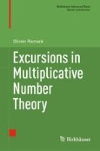- About MAA
- Membership
- MAA Publications
- Periodicals
- Blogs
- MAA Book Series
- MAA Press (an imprint of the AMS)
- MAA Notes
- MAA Reviews
- Mathematical Communication
- Information for Libraries
- Author Resources
- Advertise with MAA
- Meetings
- Competitions
- Programs
- Communities
- MAA Sections
- SIGMAA
- MAA Connect
- Students
- MAA Awards
- Awards Booklets
- Writing Awards
- Teaching Awards
- Service Awards
- Research Awards
- Lecture Awards
- Putnam Competition Individual and Team Winners
- D. E. Shaw Group AMC 8 Awards & Certificates
- Maryam Mirzakhani AMC 10 A Awards & Certificates
- Two Sigma AMC 10 B Awards & Certificates
- Jane Street AMC 12 A Awards & Certificates
- Akamai AMC 12 B Awards & Certificates
- High School Teachers
- News
You are here
Excursions in Multiplicative Number Theory

Publisher:
Birkhäuser
Publication Date:
2022
Number of Pages:
360
Format:
Hardcover
Price:
84.99
ISBN:
978-3-030-73168-7
Category:
Monograph
[Reviewed by , on ]
Allen Stenger
05/9/2022
The subject matter of this book is arithmetic functions (that is, functions defined on the positive integers), and usually multiplicative functions (arithmetic functions \( f \) that satisfy \( f (mn) = f (m)f (n) \) when \( m \) and \( n \) are relatively prime). Multiplicative number theory is closely related to prime number theory. The focus in this book is primarily on developing asymptotic average values of multiplicative functions.
This is not a comprehensive book, but it does touch on a wealth of topics and techniques. This is not exactly a problem book, but it comes close. Typically one theorem will be proven as a model, and then a half-dozen or so problems are stated that can be worked by the same method. Some difficult problems are broken down into a series of steps, and there are hints for most of the problems in the back of the book.
The excursions are divided into three major sections, called the Walks:
The Convolution Walk: The initial step in all of these excursions is the Dirichlet convolution, which is usually then coupled with Dirichlet series to get a growth estimate. These are all essentially elementary number theory, although they do use a small amount of real analysis for the estimates. This Walk includes a very interesting Chapter 9 on how to get precise numerical estimates for Euler products, that is, products over the primes of the form \( \Pi_{p} h(p) \) where \( h \) is an analytic function with the growth condition \( h(z) = 1 + O(z^{2}) \) as \( z \rightarrow 0 \). These often occur as the answers in these convolution problems, and the obvious approach of taking the product over lots of primes works poorly; instead, this chapter shows how to express them in terms of values of the Riemann zeta function, which we do know how to calculate very precisely.
The Levin–Faı̆nleı̆b Walk: Most of these excursions involve congruences and arithmetic progressions. These excursions also belong to elementary number theory, although with heavier use of real analysis. Dirichlet’s theorem on primes in arithmetic progressions is not proved here, although there is a proof of the special cases for moduli 3 and 4. (The hardest thing to prove in Dirichlet’s theorem is that the L-function does not vanish at 1, but this is easy to prove for these two moduli; these special cases allow us to study and understand the ideas of the whole proof without getting bogged down on the non-vanishing.) The name Levin–Faı̆nleı̆b refers to a 1967 paper by B. V. Levin and A. S. Faı̆nleı̆b about applying integral equations to number theory, that provides the initial inspiration for these methods.
The Mellin Walk: This deals with the Mellin transform, an integral transform that is closely related to the Laplace and Fourier transforms, and that is especially useful in number theory to extract weighted sums of the coefficients from a Dirichlet series. This section is shorter than the others and deals with the prime number theorem and asymptotics of several sequences. This is the only one of the Walks that has a substantial amount of complex analysis, and is the one most closely related to analytic number theory.
These three Walks are bracketed with: a long introductory section on multiplicative functions and techniques for manipulating them, and a selection of more advanced topics dealing with sieves, exponential sums, and the large sieve.
The book is easy to read. The English is unidiomatic at times, and occasionally a wrong word is used, but this is usually not confusing. I spotted a few typos, but these also were not confusing. The material has been taught by the author at Marseille, and there is a section at the beginning suggesting how to structure a short course (one semester), concentrating on one of the Walks; the whole book would take about three semesters.
Three Very Good Features: (1) the book emphasizes explicit constants in the bounds and the error terms (instead of plain big-Oh results); (2) the book is thoroughly footnoted, including references to the original papers and modern expositions; (3) the book includes a large number of scripts in Pari/GP and Sage that are used for verifying the explicit results for small values of the argument.
Another good book, that is simpler than this one but covers some of the same material, is Pollack and Singha Roy’s Steps into Analytic Number Theory. Two more advanced books, that cover the subject of arithmetic functions thoroughly, are Paul J. McCarthy’s Introduction to Arithmetical Functions and Wolfgang Schwarz and Jürgen Spilker’s Arithmetical Functions.
Allen Stenger is a math hobbyist and retired software developer. He was Number Theory Editor of the Missouri Journal of Mathematical Sciences from 2010 through 2021. His personal web site is allenstenger.com. His mathematical interests are number theory and classical analysis.
See the publisher's website.
- Log in to post comments




